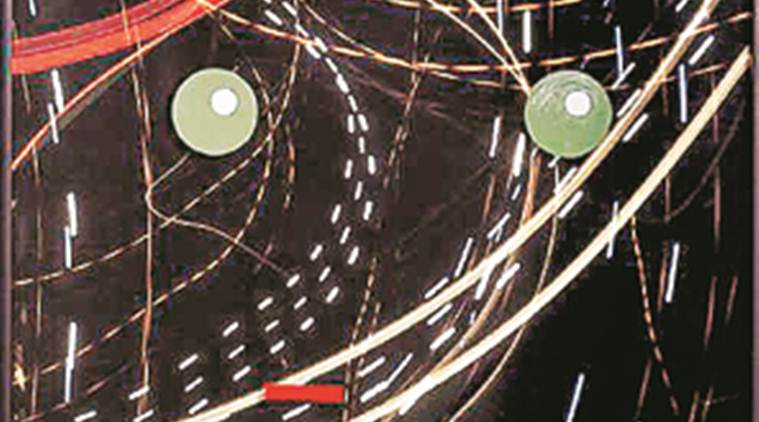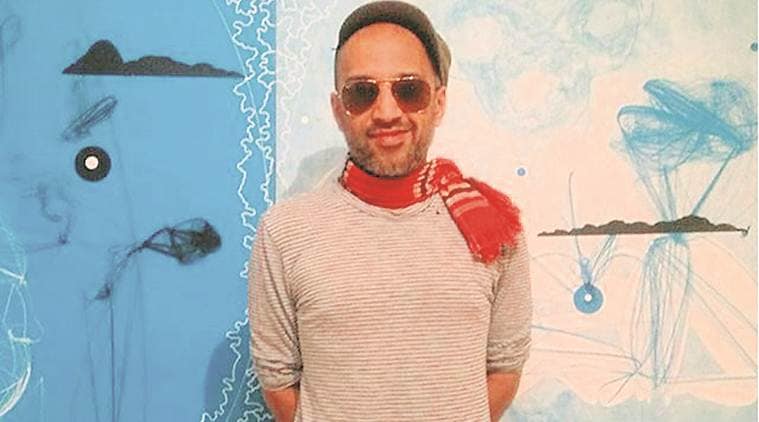
A galaxy filled with several bright white and yellow lines that are interrupted at many intervals — much like how cars plying on Delhi’s roads during peak hours have to press the breaks — form the dominant narrative in artist Aditya Pande’s “Ring Road Drawing” series.
These mixed media works on display at Nature Morte are captured in pitch dark. For them, Pande photographed the ring roads in Delhi with long camera exposures at night, using the motion of taxis, traffic and lights as his guiding force. Pande shares how he followed certain lights — traffic lights, ambient lights, advertising lights, motorcycle lights and LED lights of buses — on the roads for works like Lala Lajpat Rai (Ring Road Drawing), Bahadur Shah Zafar (Ring Road Drawing) and Nelson Mandela (Ring Road Drawing), titled after the historical figures on whom the roads have been named. Combining digital, hand-drawn and collaged images, the red circles with popping eyes that Pande peppers in between seem reminiscent of the faces of these people.
Over a decade ago, in an interview with gallerist Peter Nagy, Pande had said, “I enjoy that point of ambiguity where you are not sure whether these are drawings, or have been painted or printed upon.”

The 26 mixed media works include drawings that are hand-drawn and computer generated and photographs. The solo titled “Saturday” opened on the same day it is titled after and also has references to the day of leisure being named after the Roman god Saturn. Pande says, “It is like an overarching statement for a kind of time and location. A lot of these works draw upon archaeology, city and mythology and it is almost like an intersection of various spaces we inhabit.” A graduate in communication design from National Institute of Design, Ahmedabad, he has exhibited at the Kiran Nadar Museum of Art in Noida, Nature Morte in Berlin, Otto Zoo in Milan and Bose Pacia in New York, among others.
Appearing like a deep labyrinth left for the viewers to decipher and uncover one by one, Pande’s canvases oscillate between many subjects. Bearing a mythological reference, the focus of his triptych Dug Dug Dig is a small dog sculpture, resting beneath the famous Harappan Dancing Girl on display at the National Museum in Delhi, which rests atop a collage comprising the photograph of the site from where it was excavated, Mohenjo Daro. Pande says, “The tiny dog on display below Dancing Girl doesn’t get much recognition but here he is seen walking around. I am fictionalising certain narratives and mythology and juxtaposing them. It’s like a symbol of our time, where the power of mythology is mediated through technological spaces.”
As if the end result of a child’s hand, strange creatures that are playful yet terrifying and scary at the same time stare back at the viewer in the show. Against the backdrop print of crystal white ice, Pande draws a yellow mouse-like figure in Boltzmann’s Constant Worry (2013), while referring to the Boltzmann constant in physics. A hybrid bird-like figure and a black cupid inhabit the space surrounding the treasured Harappan red jasper male torso — which is housed at the National Museum — in Pande’s monochrome
A Solution Without a Problem. His first solo “A to Zoo” at Chatterjee and Lal in Mumbai in 2008 had similar characters, where he presented works that referenced zoography, hybridised insects, animals and humans, that continue to populate his canvases even today.
The exhibition is on till May 4 at A-1, Neeti Bagh